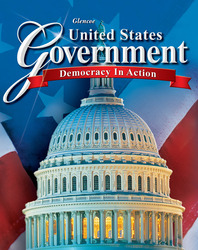United States Government: Democracy in ActionChapter 23:
State GovernmentsChapter Overviews[logo] Essential Question
How is your state government structured, and why does it have more direct influence over citizens' lives than any other government unit? Section 1 State Constitutions
State constitutions are the basic law of the state and create the structure of state government, providing for separation of powers among the legislative, executive, and judicial branches. State constitutions outline the organization of each branch, the powers and terms of various offices, and the method of election for state officials. State constitutions also establish the different types of local government: counties, townships, municipalities, special districts, parishes, and boroughs. In addition, state constitutions regulate the ways state and local governments can raise and spend money. Finally, state constitutions establish independent state agencies, boards, and commissions that affect citizens' lives directly. Although state constitutions vary widely, all contain a bill of rights. Most are lengthy and filled with details. They provide four different methods of proposing amendments: by state legislatures, by popular initiative, by a constitutional commission, or by a constitutional convention. All states except Delaware require ratification of amendments by popular vote. When the voters rather than the legislature vote on an issue, it is called a referendum. In order to replace existing state constitutions, most states require a constitutional convention. Section 2 The Three Branches
State government is divided into three separate branches: the legislature, the executive, and the judiciary. State legislatures pass laws that deal with such issues as health, crime, labor, education, and transportation. They have the power to tax and the power to spend and borrow money. State legislatures also act as a check on the power of the governor and the bureaucracy. They are known by various names, including the general assembly, general court, and legislative assembly. All but one state—Nebraska—have bicameral legislatures. Members of state legislatures are elected from districts of relatively equal population. Most work only part time and are not well paid. The size and population of a state does not determine the size of its legislature. On average, lower houses have about 100 members, and state senates average about 40 members. Bills originate in either house, and follow a course similar to that in the U.S. Congress to become law. Every state has an executive branch headed by a governor. Most governors have served in state and local government before running for governor. In most states, a candidate for governor must win a party primary and then win a plurality in the general election. Most governors serve four-year terms. The governor's responsibilities include proposing and signing (or vetoing) legislation, budgeting, appointing officials, planning for economic growth, coordinating the work of executive departments, exercising military powers over the state National Guard, and visiting foreign countries. Other elected officials from different political parties may head executive offices, including the attorney general, secretary of state, and state treasurer. State courts interpret and apply state and local laws. They decide most criminal cases of murder, assault, and reckless driving. They also decide civil cases and cases that involve local laws. State court systems include minor courts (justice courts, police courts, municipal courts, magistrate courts), general trial courts, and appeals courts. The highest state court is the state supreme court. State judges are selected in four different ways: popular election, election by the legislature, gubernatorial appointment, or the Missouri Plan method. Judges may be impeached or recommended for removal by a disciplinary board. Section 3 State Government Policy
In most states, the major areas of legislative activity are business regulation, controlling and regulating natural resources, protecting individual rights, and implementing health, education, and public welfare programs. Almost all states have laws regulating landlord-tenant relations, health-care industries, consumer sales and service, public utilities, the safety and sanitary conditions of the workplace, pollution permits, and land use. Protecting life and property is the responsibility of state and local governments. The states' correction systems include state prisons and county and municipal jails. Health, education, and welfare programs combined make up the largest part of state spending. Section 4 Financing State Government
State taxes raise nearly half of the general revenue of state governments. Sales tax is the largest source of state revenue. State individual income taxes and corporate income taxes account for some 30 percent of state tax revenues. State governments borrow money by selling bonds. Nearly three-fourths of the states run public lotteries to raise revenue. The federal government provides about 20 percent of all state revenues through intergovernmental revenue such as grants-in-aid and block grants.  | 
















